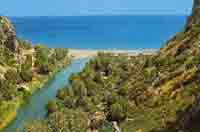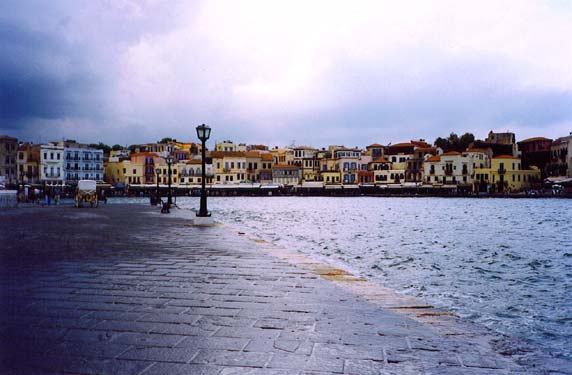

|
CRETE AT ONE GLIMPS SIZE Crete is the fifth biggest island in the Mediterranean Sea - about 8.300 square kms big, length 270 kms, width between 16 and 60 kms. HIGHEST PEAK is Timios Stavros (2.456 m) in the Ida mountain-range followed by Pachnes in Lefka Ori mountain-range. PLAINS The biggest plain with 140 square kms is the plain of Messara in the south of central Crete. Further big plains are found around Hania and Rethymnon. POPULATION Around 600.000 people are living at the island, for the size of Crete it is not very much. About 120.000 are living in the capital Heraklion. The biggest cities Hania, Rethymnon and Agios Nikolaos are situated at the north coast, Sitia at the east coast and the one and only big city in the south is Ierapetra. ADMINISTRATION Crete is one of the ten states in Greece and divided into four counties, the so called Nomoi: Hania (capital Hania), Rethymnon (capital Rethymnon), Heraklion (capital Heraklion) and Lassithi (capital Agios Nikolaos). ECONOMICS About 30 percents of the whole area of the island are used for acriculture, the main export goods are olive oil and grapes (vine and raisins). Industrial areas in small style are found around Heraklion. The main source of income is tourism. In average there are visiting around 1,5 to 2 millions foreigners the island every year. <UNIVERSITY The University of Crete contents 5 faculties in Rethymnon (languages, philosophy, social studies, psychology and pedagogics) and 4 faculties in Heraklion (physics, mathematics, chemistry and medicine). There is also a polytechnic college in Hania.
CRETE IS DIFFERENT Crete lies like no other island of the Mediterranean in the point of intersection of Asia, Africa and Europe. It always was influenced by those continents. Crete could survive and keep its own identity, because it always was defending itself and also mediating. Obvious this ha engraved the mentality of the Cretans for ages: their famous pride as well as the friendliness and openness towards the foreigner, hho is always welcome as a guest. For sure, the Minoan area is the oldest European culture and has its origins in the third millennium BC. Daedalos, the inventor of the human flight, was the architect of Knossos. The Greek alphabet - and together with it the European alphabet - was developed from the so called linear-B alphabet. Also law was originated in Crete, still one can admire the first written laws of Europe, which are caved into a stone, at Gortys in the plain of Messara. About 1600 BC the Cretan empire was destroyed, either by man or by a big natural catastrophy - nowadays nobody can tell for sure. But about 1425 BC Crete was conquered by the Mycenians and later on by the Dorians. The Romans set an end to the small states of the legendary 100 cities in 69 BC and were the first who started timbering the Cretan woods in big style using the wood for building their fleet. After 1945 a merciless civil war, which took place in whole Greece, also effected Crete. A lot of communistic partisans had been shot by the government's troops. The one who is visiting nowadays Crete, will recognise these stories, if he takes a closer look. But the openness of the Cretans is obvious. They love easy going and enjoy life very much, they tell a lot of stories and legends with cheerful mockery. The seriousness of a situation is mastered by minimising it. The burdensome way (dromos) becomes to the tiny one (dromaki) and the wine, which makes you drunk (krassi) becomes to the tiny one (krassaki). BETWEEN COAST AND MOUNTAINS Cretan landscapes are full of variety and contradictions. The north coast towards the Aegean is significant for wide and shallow beaches. Here in the north there is also the only highway (New National Road) with a length of 290 kms going from the west Kastelli/Kissamos to the outer east, connecting the four provincial capitals. The north has a highly developed touristic infrastructure - with all its bad sides. The one who wants to get to know the original Crete has to go to the inner land and the south coast. The south is mainly steep stony and hot. WEST CRETE The island's west is the wildest, most mountainous and greenest part of Crete, its landscape is dominated by the peaks and gorges of the mountain-range of the White Mountains or Lefka Ori. This part of the island is inviting for trekking - either along the coast, through the gorges or into the mountains. Always you can find beautiful and secluded beaches, which want to be discovered. There are only a few roads through the mountains leading down south to the Libyan Sea. The main mean of transportation between Paleohora and Hora Sfakion are boats. HANIA is the biggest city and the capital of the province. Around 60.000 people are living here and it is a really charming city with a lot of green. It is also interesting to visit one of the three museums of the city: Outside of Hanna at the Akrotiri peninsula it is worth two visit the monasteries of Agia Triada and Guvernetou. Here the tomb of the most important Cretan politican Eleftherios Venezielos is found. And last but not least the world famous movie Zorbas the Greek with Anthony Quinn was made here. Main scene of action was the little village Stavros. THE PROVINCE HANIA with its two counties Selino and Sfakia is offering various possibilities to make excursions. At the south west coast there is a beautiful rose colored beach with a tiny island opposite, called Elafonissos. It can be reached by feet, as the water is very shallow between the beach and the island. The water is occurring in various facets of green and blue. Tons of very fine grained sea shells make the rose color of the sand. Tamarisks and other plants give shelter against the sun and there are a lot of small bays around. Unfortunately this small paradise is suffering during high season of garbage, which is left by the hundreds of daily visitors. 5 kms north of this beautiful place lies the the monastery Chrissoskalitissa with its glomming blue dome. The translation of the word Chrissoskalitissa means the golden step and as the legend tells, there is a step made of pure gold, which only can be seen from those, who are without any sin... Very unorthodox is the staff of the monastery: one nun and one monk. Following the road to the north one reaches the village of Elos. This quiet and moody place is famous for chestnut trees. At the third Sunday of October there takes place a big festival for the end of the harvest. A few kms north there is the cave of Saint Sofia with white, bizarre stalactites. At the entrance of the cave a little chapel was built. 
Near Paleohora lies the little mountain village Azogires, which is surrounded by a green and rich in water landscape. Above the village the caves of the Holy Fathers is found. In direction to the east along the coast were found ruins of an ancient port town, called Lissos, which had a famous spa and the temple of Asklepios. Further along the coast a little fishing village, with a handful of houses and placed in a wide and sheltered bay is welcoming its visitors - Sougia. In the valley which ends up in Sougia a very nice gorge is situated - the Agia Irini gorge, not that well known like the big sister, the Samaria gorge, but for that reason much more quiet and less visited. The very famous Samaria gorge with a length of 18 kms is the longest gorge of Europe. Climbing down from 1.200 m up in the White Mountains to sea level, it ends up at the Libyan Sea in the little village Agia Roumeli. Magnificent beauty of nature, rare plants and the Cretan wild goat the so-called Kri Kri are worth to visit this National Park, which was founded in 1962 by the Greek government. Up to 600 m high rock walls are guiding the visitor through the gorge and at the Iron Door or so-called Sideroporta they become narrow to 3 m. Further east one comes to the little village Loutro, which only can be reached by sea. The various small beaches and bays in the neighborhood are wild-romantic and can also reached only by boat or by feet. East of Hora Sfakion, from where the boats to Agia Roumeli and Sougia start, there is a big Venetian castle, Frankokastello, the walls are pretty well conserved. Nice sandy beaches, a lot of bamboo and the mountain-range of the White Mountains in the back create a beautiful scenario. The most south island of Europe, Gavdos lies 32 nautical miles off the coast of Crete. It is one of the most original and extraordinary places of Greece. The leading elements are quietness, wind and rocks. During the summer the government sends to its main village Kastri a policeman and a doctor. The population is spread over 4 little villages. The isle is supplied three times a week by a boat from Paleohora, which also takes passengers there. 
In THE PROVINCE RETHYMNON the next jewel of the south coast is found - the palm tree beach of Preveli. White sand, palm, eucalyptus trees and oleander along a little river and enclosed by high raising rocks it has been traded as a secret by Crete's visitors. Years ago young people from whole Europe came here to spend their summer away from civilization, nowadays it is a popular destinations for day trippers. Beyond the valley there are two monasteries, one of them still run by some nuns. At National Road at the north coast not far away from the junction to the south lies a little shady village, named Vrisses. Mighty plane trees are growing along the river and are the right place to take a break. The village's specialties are lamb from the charcoal and a very tasty and mild yogurt with honey. Near Georgioupolis at the north coast the one and only sweet water lake is found. In the lake Kournas live crabs, turtles and a couple of ducks. The area is a popular aim at weekends for the locals from Hanna. RETHYMNON, the capital of the province, is a moody and sympathetic little city, which has a worth-to-seen old town with minarets and mosques, tiny narrow streets and the typical houses from the Turkish period and also parts of the old town wall. The old town is situated at an peninsula, watched from the peak by a Venetian fort, the Fortezza , built in the 16th century and has a really pretty Venetian port. Also worth to be seen are theArimondi well and the assembly house of the Venetian nobles, the Porta Guora East of Rethymnon there is the famous monastery Arkadi. The nowadays buildings were built in the 16th and 17th century, but there has been a church or a monastery 500 years before. For the Cretans it is the most important building, reminding of the cruel period of the Turkish occupation and the heroines of the past time. The buildings themselves are not that impressionable, what counts is the tragedy which took here place at the 9th of November 1866, hundreds of men, women and children committed suicide, because they did not want to be caught by the Turkish troops. Although the world got to know, what happened there, it lasted another 30 years, that Crete became independent. CENTRAL CRETE THE PROVINCE HERAKLION is the heart of the island. It has the capital of Crete, the highest mountain-range, the biggest plain, the highest density of population and the most important archeological site of the island. Heraklion became due to its good port and the central position to the economical center of the island. Most of the important industries of Crete are found here. The north coast between Agia Pelagia and Malia is the biggest area of tourism of the island with the highest density of accommodations. About 90% of the visitors of the island arrive in Heraklion. HERAKLION is Crete's biggest city and its capital and neither the less interesting, although there is not so much left from its turbulent past. All the sightseeing points are situated inside the more or less well preserved town wall. It has a length of 5 kms, its 7 bastions and 4 gates gave 21 years resistance against the Turkish attacks, finally in 1669 Heraklion was conquered. At the Martinengo bastion the world famous writer Nikos Kazantzakis found his last resting-place. Because of his sharp critics against the church he was excommunicated and the Greek-orthodox Church still refuses to give him a grave at a graveyard. Pride, deepest loneliness and affliction about the ignorance of his fellow human beings expresses the aphorism, which is engraved in a little slab: I do not hope for anything, I do not fear anything, I am free! KNOSSOS Just a few kms outside of the city lies the unique excavations of the mysterious palace of the legendary King Minas, it is one of the most important monuments of the early history. It took about 30 years hard work by Sir Arthur Evans to uncover this huge area. Those things, buried for milleniums in the earth of Crete, have been a real sensation, when they have been discovered. It was the proof, that there was existing a highly developed culture long before the classical antiquity of Greece. Still there are a lot of theories, speculations and conjectures about the palace. The spectrum starts with an over dimensioned tomb ground, goes to a cult sanctuary and ends at the most common assumption, that it was a big palace (a center of reign, administration and cult). Further east lies the Minoan palace of Malia. The village of Malia is one of the sea resorts which do not have to do anything with the original Crete. Southwest of Heraklion, situated in the Ida mountain-range, lies the village Anougia, which got a very sad publicity during World War II. While the German's reprisals against the Cretans in August 1944 all the male inhabitants of the village had been shot as partisans. Anougia is the largest Cretan mountain village. Some of the best musician families have their roots here, like Xilouris and Skoulas. From here the road goes to the high plain of Nida, where the cave of Zeus is situated, in which he was hidden from his father, who wanted to eat him up. EAST CRETE THE PROVINCE LASSITHI with its capital Agios Nikolaos offers some highlights of landscape beside the plain of Lassithi. |
© SCI 2003 - 20XX // all rights reserved
 The favour of its position let become Crete to a bridge between continents and cultures But for Europe Crete was playing a main roll as it is clearly seen at the Greek mythology.
The favour of its position let become Crete to a bridge between continents and cultures But for Europe Crete was playing a main roll as it is clearly seen at the Greek mythology. After 395 Crete was belonging politically to the East Roman (Byzantine) empire, the official church although still was the Roman.
After 395 Crete was belonging politically to the East Roman (Byzantine) empire, the official church although still was the Roman. Hania is a wealthy place, very distinguished, giving home to a naturally grown middle class, which likes to enjoy life and tradition. The old town with its Venetian and Turkish houses is renovated with a lot of money and very tastefully. The highlight, which nobody should miss to have a look at, is the Venetian port. As well you can find parts of the old town wall from various periods from the Mycean untill the Classicism of the 19th century. Another highlight is the market hall, which is the most beautiful of the island. Built in 1923 it was designed after the market halls of Marseille in France. You can find there daily, except Sundays fresh meat, fish, vegetables, dairy products and spices offered direct by the farmers. Also worth to be seen is the city park, which also gives home to a little zoo. Very famous is the Leather street of Hanna, with its big variety of leather goods.
Hania is a wealthy place, very distinguished, giving home to a naturally grown middle class, which likes to enjoy life and tradition. The old town with its Venetian and Turkish houses is renovated with a lot of money and very tastefully. The highlight, which nobody should miss to have a look at, is the Venetian port. As well you can find parts of the old town wall from various periods from the Mycean untill the Classicism of the 19th century. Another highlight is the market hall, which is the most beautiful of the island. Built in 1923 it was designed after the market halls of Marseille in France. You can find there daily, except Sundays fresh meat, fish, vegetables, dairy products and spices offered direct by the farmers. Also worth to be seen is the city park, which also gives home to a little zoo. Very famous is the Leather street of Hanna, with its big variety of leather goods.